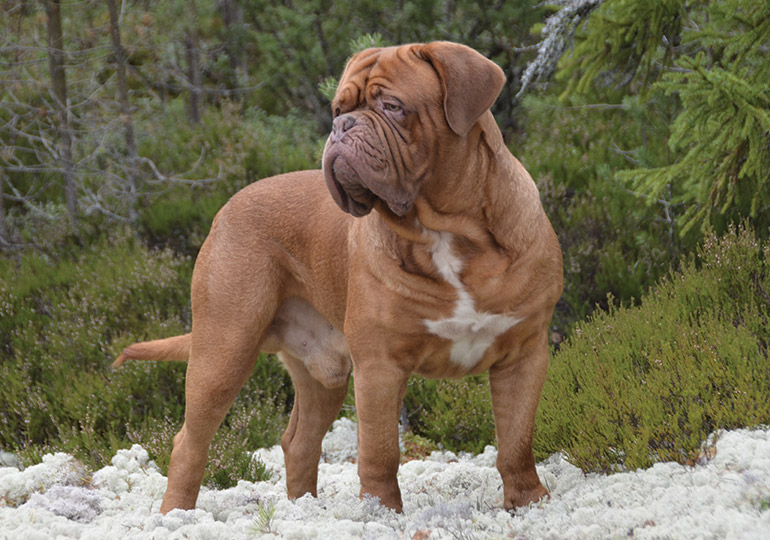Breeds
Dogue de Bordeaux

GROUP 6 - UTILITY
History
While mastiff types were noted throughout history, in France from the 14th century onwards, the Dogue de Bordeaux did not become known by this name until the mid-19th century. The breed has been used throughout history as a fighting dog, for bear and bull baiting, for draught and droving work (hauling the butcher’s cart, taking wounded soldiers from the battlefield and moving cattle) and as a guardian.
Appearance
The breed has a heavy, lower set, muscular body with strong bone. The specific elements of type, most notable in the head, are the ‘trapezoid’ skull shape (from above and in front), short muzzle (brachycephalic), high set nose, repandous jaw and strong chin mark. The body should be pear shaped, with a broad and deep chest (slightly shorter in leg than the depth of chest) with a harp-shaped underline.
Temperament
The breed is naturally gifted for guarding, but should be calm and balanced. Males tend to be dominant. Puppies should be well socialised from the earliest occasion following final vaccination, and are excellent with other animals if given the opportunity of early exposure.
Health
The breed comes from a small gene pool, and as such suffers a number of heritable disorders. Hip and elbow dysplasia is encountered, as is osteochondritis dessicans (OCD), most commonly of the shoulder joint. Subaortic stenosis (SAS) is a common heritable heart condition in the breed. Breeding animals should be hip, elbow and heart certified by relevant specialists.
Brachycephalic obstructive airway syndrome is an issue and breeders should select for clean breathing animals. In this regard owners should aim to keep their Dogues in lean body condition, as excess weight can make it more difficult for the dog to keep cool and exacerbate the condition.
Allergy based skin conditions occur, and demodectic mange can be another cause for concern. Epilepsy has been known to occur, but appears to be more isolated.
Footpad hyperkeratosis is a recognised genetic disease for which there is a genetic test available, but it does not appear to be common in Australian Dogues.
The Dogue de Bordeaux, as with most deep chested breeds, is prone to bloat (gastric dilatation volvulus).
Suitability
The Dogue de Bordeaux forms a strong bond with his or her family and this, coupled with coming from a cooler climate, means they are most suited to being an inside dog. As such, you will need to be able to cope with slobber! With their high muscle mass and shortened muzzle, they need to be able to seek a cool area in our hot weather (air-conditioning, bathroom tiles).
The Dogue de Bordeaux are natural guardians, but also make excellent family dogs with a particular patience and love of children. They are only moderately active, but enjoy water (generally they love to swim and play in water), and retain something of a puppy like nature even in old age.
Words: Dr Yvette Girling DVM
Image by C & Y Girling
In Conclusion
Now you know a little about the Dogue de Bordeaux, you may have think that this is the dog for you. Before you make a decision, please make contact with the breed club or your State controlling body for purebred dogs. They will be able to give you information about available puppies and also suggest dog shows where you can see the breed and speak to breeders. In this way you will gain a better perspective of the Dogue de Bordeaux and its needs and whether this breed would suit your lifestyle.
Breeders



